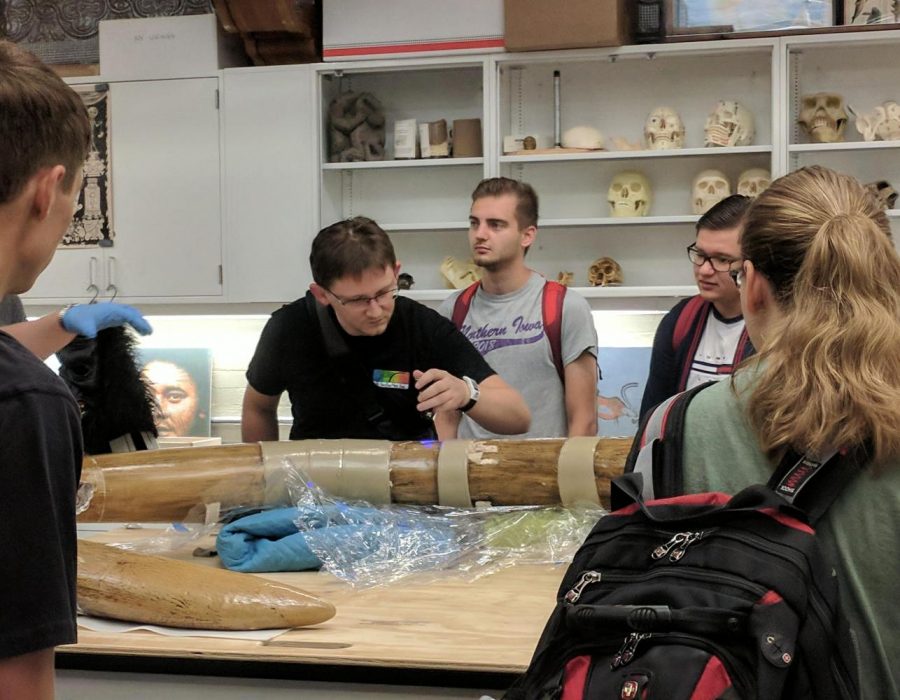UNI Museum’s mastodon tusk to be restored
Some UNI students have acquired the opportunity to examine the mastodon tusk first-hand, thanks to a recently received grant. The tusk has been in possession of the UNI Museum for almost 100 years.
Oct 12, 2017
For nearly 100 years, the UNI Museum has possessed a mastodon tusk that is estimated to be between 50,000 and 150,000 years old. It’s been in storage for the last 50 years, but thanks to a grant of more than $300,000 by the Roy J. Carver Charitable Trust, it can now be restored and stabilized.
Awarded in 2016, the grant was written for three years, and the museum is currently a third of the way through the restoration process.
According to Nathan Arndt, the assistant director and chief curator for the UNI Museum, the tusk was found in 1933 in Hampton, Iowa in a gravel pit.
“At that time, the museum was still active,” Arndt said. “We’ve been around for over a hundred years, and Dr. Cable, who was the head of the museum at the time, thought it would be a nice addition to the museum here.”
The tusk was displayed until the ‘60s. But the standards for the time didn’t keep the tusk safe, according to Arndt. While in open display, the tusk suffered water damage from a leaking roof. Now with the grant, the museum is finally getting the opportunity to fix it.
Laura Kubick is the conservator, and Ellie Akers, a UNI senior majoring in anthropology, is her assistant. For Akers, the experience has confirmed her passion for conservation.
“I’ve tested samples; I’ve done all the research for it,” Akers said. “I’ve been doing a lot of back and forth with the conservator, gathering research for the field that I actually wanna go into after I graduate.”
Throughout this process, one of the museum’s major partners has been the chemistry department, especially Assistant Professor Josh Sebree and his Instrumental Analysis class.
“This year’s class is involved in kind of the phase one: understanding the current state of the tusk and then [. . .] the initial cleanup of it,” Sebree said. “Next year’s class is going to start taking the first data of phase two, which is the final conservation efforts. So, from there, next year’s class and the year after will [. . .] continue monitoring the tusk.”
Dr. Sebree’s class is concerned with the chemical safety issues that the tusk presents. The presence of lead on the tusk is one major concern. According to Sebree, there may also be arsenic in some of the lacquers. Many of the dangers are still unknown.
“[I]n the first six weeks of the course, [students have to] come up with a research idea of how they’re going to answer some of the questions that were brought up in the original Carver proposal that was awarded to understand this tusk better,” Sebree said.
After the students’ proposals are reviewed by their peers and externally reviewed outside of their group by a panel of experts, students get their own small pieces of tusk for analysis.
One of the external reviewers for the students’ proposals is Anne Marie Gruber, who is the instruction and liaison librarian and assitant professor at the library. It is her job to help the students research effectively.
“One of the hard things for the students, I think, in the research has been that there aren’t many mastodon tusks out there,” Gruber said. “So that means that there aren’t very many researchers that are publishing articles about the sorts of things that the students are doing. That’s been challenging, because when you’re doing research that nobody’s done and you’re breaking ground like that, you still need to rely on sources that already exist. So, we’ve been using things from research about dentistry, research about art conservation, research about other species like elephants and wooly mammoths.”
The students’ research is available through the online repository ScholarWorks, so the rest of the world can access this work. Arndt hopes the state of Iowa sees the value of the research.
“There’s samples all over the state that are having the same issues, because this [was] standard protocol for the time period,” Arndt said. “How can we help the state best take care of their tusks? So, this is groundbreaking work that we’re hoping to do, to help people maintain their collections across the state.”
In approximately two years, the tusk will return to display, accompanied by a digital interactive.
In the meantime, the UNI museum will have a livestream of the conservation efforts available on their webpage soon.
“This will show what a modern museum is capable of and how it influences and impacts your life,” Arndt said. “Doing this will also show people UNI is relevant in the world of academia — we do great things.”








